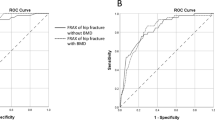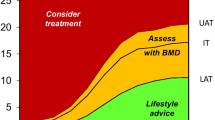Abstract
Introduction
The aim of this study was to develop an algorithm to identify high-risk populations of fragility fractures in Taiwan.
Materials and methods
A total of 16,539 postmenopausal women and men (age ≥ 50 years) were identified from the Taiwan Osteoporosis Survey database. Using the Taiwan FRAX® tool, the 10-year probability of major osteoporotic fracture (MOF) and hip fracture (HF) and the individual intervention threshold (IIT) of each participant were calculated. Subjects with either a probability above the IIT or those with MOF ≥ 20% or HF ≥ 9% were included as group A. Subjects with a bone mineral density (BMD) T-score at femoral neck based on healthy subjects of ≤ − 2.5 were included in group B. We tested several cutoff points for MOF and HF so that the number of patients in group A and group B were similar. A novel country-specific hybrid intervention threshold along with an algorithm was generated to identify high fracture risk individuals.
Results
3173 (19.2%) and 3129 (18.9%) participants were categorized to groups A and B, respectively. Participants in group B had a significantly lower BMD (p < 0.001), but clinical characteristics, especially the 10-year probability of MOF (p < 0.001) or HF (p < 0.001), were significantly worse in group A. We found the algorithm generated from the hybrid intervention threshold is practical.
Conclusion
The strategy of generating an algorithm for fracture prevention by novel hybrid intervention threshold is more efficient as it identifies patients with a higher risk of fragility fracture and could be a template for other country-specific policies.



Similar content being viewed by others
References
Report of a WHO Study Group (1994) Assessment of fracture risk and its application to screening for postmenopausal osteoporosis. World Health Organ Tech Rep Ser 843:1–129
Kanis JA, Borgstrom F, De Laet C, Johansson H, Johnell O, Jonsson B, Oden A, Zethraeus N, Pfleger B, Khaltaev N (2005) Assessment of fracture risk. Osteoporos Int 16:581–589 (in eng)
Siris ES, Genant HK, Laster AJ, Chen P, Misurski DA, Krege JH (2007) Enhanced prediction of fracture risk combining vertebral fracture status and BMD. Osteoporos Int 18:761–770 (in eng)
Kanis J, Johnell O, Odén A, Johansson H, McCloskey E (2008) FRAX™ and the assessment of fracture probability in men and women from the UK. Osteoporos Int 19:385–397
Kanis JA, Johnell O, Oden A, Johansson H, McCloskey E (2008) FRAX and the assessment of fracture probability in men and women from the UK. Osteoporos Int 19:385–397
Fujiwara S, Nakamura T, Orimo H, Hosoi T, Gorai I, Oden A, Johansson H, Kanis JA (2008) Development and application of a Japanese model of the WHO fracture risk assessment tool (FRAX). Osteoporos Int 19:429–435
Kanis J, McCloskey E, Johansson H, Strom O, Borgstrom F, Odén A (2008) Case finding for the management of osteoporosis with FRAX®—assessment and intervention thresholds for the UK. Osteoporos Int 19:1395–1408
Kanis JA, Borgstrom F, Zethraeus N, Johnell O, Oden A, Jonsson B (2005) Intervention thresholds for osteoporosis in the UK. Bone 36:22–32 (in eng)
Compston J, Bowring C, Cooper A, Cooper C, Davies C, Francis R, Kanis JA, Marsh D, McCloskey EV, Reid DM, Selby P, National Osteoporosis Guideline G (2013) Diagnosis and management of osteoporosis in postmenopausal women and older men in the UK: National Osteoporosis Guideline Group (NOGG) update 2013. Maturitas 75:392–396
Kanis JA, McCloskey EV, Harvey NC, Johansson H, Leslie WD (2015) Intervention thresholds and the diagnosis of osteoporosis. J Bone Miner Res 30:1747–1753 (in eng)
Kanis JA, Harvey NC, Cooper C, Johansson H, Oden A, McCloskey EV, Advisory Board of the National Osteoporosis Guideline G (2016) A systematic review of intervention thresholds based on FRAX: a report prepared for the national osteoporosis guideline group and the International Osteoporosis Foundation. Arch Osteoporos 11:25
Lekamwasam S, Adachi JD, Agnusdei D, Bilezikian J, Boonen S et al (2012) A framework for the development of guidelines for the management of glucocorticoid-induced osteoporosis. Osteoporos Int 23:2257–2276 (in eng)
Hwang JS, Chan DC, Chen JF, Cheng TT, Wu CH, Soong YK, Tsai KS, Yang RS (2014) Clinical practice guidelines for the prevention and treatment of osteoporosis in Taiwan: summary. J Bone Miner Metab 32:10–16
Su FM, Liu DH, Chen JF, Yu SF, Chiu WC, Hsu CY, Ko CH, Tsai CC, Cheng TT (2015) Development and validation of an osteoporosis self-assessment tool for Taiwan (OSTAi) postmenopausal women—a sub-study of the taiwan osteoporosis survey (TOPS). PLoS One 10:e0130716
Papaioannou A, Morin S, Cheung AM, Atkinson S, Brown JP, Feldman S, Hanley DA, Hodsman A, Jamal SA, Kaiser SM, Kvern B, Siminoski K, Leslie WD, Scientific Advisory Council of Osteoporosis C (2010) 2010 clinical practice guidelines for the diagnosis and management of osteoporosis in Canada: summary. CMAJ 182:1864–1873
Cosman F, de Beur SJ, LeBoff MS, Lewiecki EM, Tanner B, Randall S, Lindsay R, National Osteoporosis F (2014) Clinician’s guide to prevention and treatment of osteoporosis. Osteoporos Int 25:2359–2381
Kanis JA, McCloskey EV, Johansson H, Oden A, Melton LJ 3rd, Khaltaev N (2008) A reference standard for the description of osteoporosis. Bone 42:467–475
Chakhtoura M, Leslie WD, McClung M, Cheung AM, Fuleihan GE (2017) The FRAX-based Lebanese osteoporosis treatment guidelines: rationale for a hybrid model. Osteoporos Int 28:127–137 (in eng)
McCloskey E, Kanis JA, Johansson H, Harvey N, Oden A, Cooper A, Cooper C, Francis RM, Reid DM, Marsh D, Selby P, Thompson F, Hewitt S, Compston J (2015) FRAX-based assessment and intervention thresholds–an exploration of thresholds in women aged 50 years and older in the UK. Osteoporos Int 26:2091–2099
Donaldson MG, Cawthon PM, Lui LY, Schousboe JT, Ensrud KE, Taylor BC, Cauley JA, Hillier TA, Black DM, Bauer DC, Cummings SR, Study of Osteoporotic F (2009) Estimates of the proportion of older white women who would be recommended for pharmacologic treatment by the new U.S. National Osteoporosis Foundation Guidelines. J Bone Miner Res 24:675–680
Jarvinen TL, Jokihaara J, Guy P, Alonso-Coello P, Collins GS, Michaelsson K, Sievanen H (2014) Conflicts at the heart of the FRAX tool. CMAJ 186:165–167 (in eng)
Cheung E, Kung AW, Tan KC (2014) Outcomes of applying the NOF, NOGG and Taiwanese guidelines to a cohort of Chinese early postmenopausal women. Clin Endocrinol (Oxf) 80:200–207 (in eng)
Imerci A, Aydogan NH, Tosun K (2018) Agreement between the Turkey Guidelines and the Fracture Risk Assessment Tool(R)-based Intervention Threshold. J Bone Metab 25:79–86
Kanis JA, Harvey NC, Cooper C, Johansson H, Oden A, McCloskey EV (2016) A systematic review of intervention thresholds based on FRAX: a report prepared for the National Osteoporosis Guideline Group and the International Osteoporosis Foundation. Arch Osteoporos 11:25 (in eng)
Wainwright SA, Marshall LM, Ensrud KE, Cauley JA, Black DM, Hillier TA, Hochberg MC, Vogt MT, Orwoll ES, Study of Osteoporotic Fractures Research G (2005) Hip fracture in women without osteoporosis. J Clin Endocrinol Metab 90:2787–2793
Chie WC, Yang RS, Liu JP, Tsai KS (2004) High incidence rate of hip fracture in Taiwan: estimated from a nationwide health insurance database. Osteoporos Int 15:998–1002
Jang EJ, Lee YK, Choi HJ, Ha YC, Jang S, Shin CS, Cho NH (2016) Osteoporotic fracture risk assessment using bone mineral density in korean: a community-based cohort study. J Bone Metab 23:34–39
Leslie WD, Lix LM, Johansson H, Oden A, McCloskey E, Kanis JA, Manitoba Bone Density P (2010) Independent clinical validation of a Canadian FRAX tool: fracture prediction and model calibration. J Bone Miner Res 25:2350–2358
Jarvinen TL, Michaelsson K, Jokihaara J, Collins GS, Perry TL, Mintzes B, Musini V, Erviti J, Gorricho J, Wright JM, Sievanen H (2015) Overdiagnosis of bone fragility in the quest to prevent hip fracture. BMJ 350:h2088
Lin YC, Pan WH (2011) Bone mineral density in adults in Taiwan: results of the Nutrition and Health Survey in Taiwan 2005–2008 (NAHSIT 2005-2008). Asia Pac J Clin Nutr 20:283–291
Leslie WD, Lix LM, Johansson H, Oden A, McCloskey E, Kanis JA (2012) Does osteoporosis therapy invalidate FRAX for fracture prediction? J Bone Miner Res 27:1243–1251 (in eng)
McCloskey EV, Johansson H, Oden A, Austin M, Siris E, Wang A, Lewiecki EM, Lorenc R, Libanati C, Kanis JA (2012) Denosumab reduces the risk of osteoporotic fractures in postmenopausal women, particularly in those with moderate to high fracture risk as assessed with FRAX. J Bone Miner Res 27:1480–1486 (in eng)
Kanis JA, Johansson H, Oden A, McCloskey EV (2009) Bazedoxifene reduces vertebral and clinical fractures in postmenopausal women at high risk assessed with FRAX. Bone 44:1049–1054 (in eng)
Makras P, Vaiopoulos G, Lyritis GP (2012) 2011 guidelines for the diagnosis and treatment of osteoporosis in Greece (in eng). J Musculoskelet Neuronal Interact 12:38–42
Acknowledgements
We are indebted to the Taiwanese Osteoporosis Association for authorizing access to and managing the database. Further, we are grateful to the Merck Sharp & Dohme pharmaceutical company (Taiwan) for offering use of the mobile DXA machine during the recruitment period.
Funding
The author (TTC) received funding for this work through a grant (CMRPG8D0651) from Chang Gung Memorial Hospital (https://www.cgmh.org.tw/). This grant was responsible for data collection, input, and processing and for the associated publication fee of this article. The funder had no role in study design, data analysis, decision to publish, or preparation of the manuscript.
Author information
Authors and Affiliations
Contributions
CYH and TTC conceptualised the study. CYH, SFY, and TTC initiated the study design. TTC is the grant holder. YJS modified the study design. CHW and WCC applied for access to the database and performed data mining. YCC and HML conducted the primary statistical analysis. CYH, JFC, CHK, and JFC discussed the final results and interpreted the data. JFC, CHK, and JFC drew the figures and tables. CYH wrote the manuscript. SFY and TTC revised the article critically. TTC supervised the research group. All the authors contributed to the refinement of the study protocol and approved the final manuscript.
Corresponding author
Ethics declarations
Conflict of interest
All authors have no conflicts of interest.
Ethics approval
The local Institutional Review Board of Chang Gung Memorial Hospital approved the study (102-1878B).
Informed consent
All participants provided written informed consent before participation.
Additional information
Publisher's Note
Springer Nature remains neutral with regard to jurisdictional claims in published maps and institutional affiliations.
Appendix
Appendix
About this article
Cite this article
Hsu, CY., Wu, CH., Yu, SF. et al. Novel algorithm generating strategy to identify high fracture risk population using a hybrid intervention threshold. J Bone Miner Metab 38, 213–221 (2020). https://doi.org/10.1007/s00774-019-01046-4
Received:
Accepted:
Published:
Issue Date:
DOI: https://doi.org/10.1007/s00774-019-01046-4





